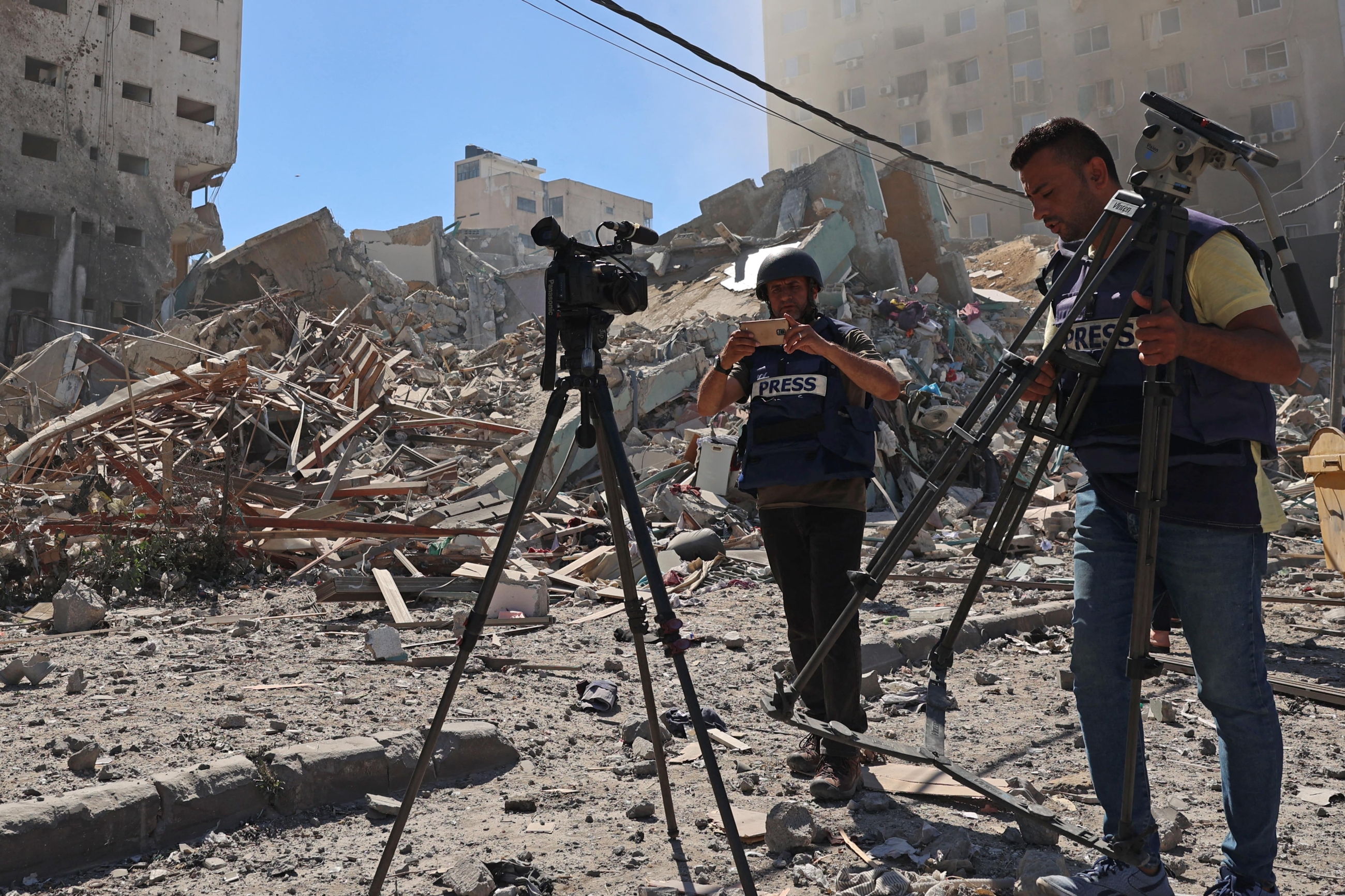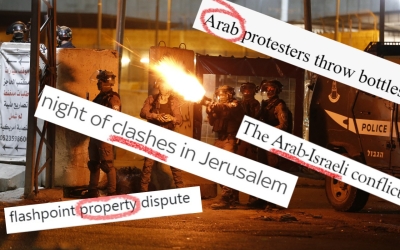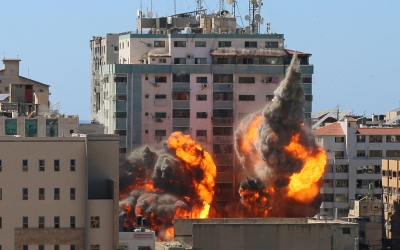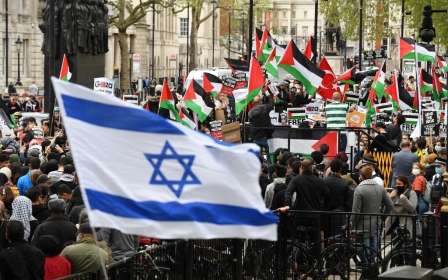Israel-Palestine: British media coverage 'skewed' and 'biased', report finds

British media coverage on the recent escalation of violence in Israel-Palestine was “biased” against Palestinians and “skewed” public perceptions, according to a new report.
On Thursday, the Muslim Council of Britain's Centre for Media Monitoring (CfMM) published a 44-page report entitled “Media Reporting on Palestine 2021”.
The report came after two weeks of violence, in which Israeli police cracked down on protests against the imminent eviction of Palestinians in the occupied East Jerusalem neighbourhood of Sheikh Jarrah, and subsequently attacked Palestinian worshippers at the al-Aqsa Mosque, wounding hundreds.
A brutal escalation followed as rockets were fired from Gaza, and Israeli air strikes on the besieged enclave killed at least 248 Palestinians, including 66 children. In the occupied West Bank and East Jerusalem, 29 Palestinians were killed. Rockets fired from Gaza killed 12 people in Israel.
CfMM stated that between 7 May and 20 May (when a ceasefire was announced), there were 62,400 online print articles and 7,997 television broadcasts reporting on the events. The report focused specifically on the British media.
Its authors found that while there were some examples of balanced coverage, the narrative was unbalanced due to “skewed language, misleading headlines and problematic framing”.
Rizwana Hamid, director of CfMM and co-author of the report, told Middle East Eye that the “overwhelming amount of complaints” received by the monitoring organisation about “British media’s biased coverage of events in Palestine” aligned with its own analysis and evidence base.
Sheikh Jarrah and al-Aqsa
The report cited several examples of media referring to the situation in Sheikh Jarrah as an “eviction” or “real estate dispute”, which it said implied a legal basis for forced displacements which were in contravention of international law.
CfMM found that 50 percent of broadcast media clips between 7 and 10 May referred to “evictions” or similar terms to describe illegal settlement plans in Sheikh Jarrah.
With regards to Israeli police violence at al-Aqsa Mosque, which resulted in hundreds of Palestinians being wounded, the report documented widespread instances of media outlets using terms like “clashes”, “conflict”, “scuffles” and “skirmishes”, implying equal blame.
“As far as language is concerned, terms such as 'evictions' mask the illegal forced removals and expulsion of Palestinians from their homes,” Hamid said. “References to 'conflict' and 'clashes' try to equalise what is in effect a battle between David and Goliath.”
Two-thirds of broadcast segments between 7 and 10 May referred to events at al-Aqsa as “clashes”, or similar derivatives, according to the findings.
It also cited several news reports speaking of an “intifada”, which it said played into “fear-mongering” and “framing Palestinians as violent aggressors”.
Another area of concern surrounding reporting on Jerusalem was an over-emphasis on religion. The report found that nearly two-thirds of 90 clips between 7 and 10 May referred to Palestinians’ religion, in some cases explicitly referring to them as Muslim.
One ITV report from 10 May referenced sirens which prompted “Jewish worshippers at the Western Wall to flee and run for cover”, and Palestinians using the “third holiest site in Islam” as a base to throw stones at Israeli police.
The authors recommended that while the religious significance of Jerusalem was important to note, journalists should avoid implying religious motivation and “portraying the history of Israel vs Palestine as [anything] other than settler colonialism”.
“This narrative ignores the existence and persecution by Israel of Palestinian Christians and others,” the report said.
Gaza framing
The report found multiple examples of problematic language and framing regarding violence in Gaza.
An article in The Sun on 12 May was titled: “Fifteen kids massacred in Israel-Hamas conflict as Netanyahu warns ‘we will inflict blows you couldn’t dream of’”. The headlined failed to mention that 14 of the 15 children killed were Palestinian.
A 17 May report in iNews said “42 died over the weekend” in its headline, but failed to mention that all of those deaths were Palestinians in Gaza.
The research also pointed out a highly circulated BBC bulletin in which a newsreader referred to Palestinians as having “died” while stating that Israelis “were killed”.
CfMM urged media outlets to avoid using a passive voice, and to clearly specify in headlines who was killed and who was responsible.
It also cited examples of media referring to the “Israeli military”, while referring to Palestinian groups as “militants” and “Islamists”, which it said implied differences in legitimacy.
There were also headlines describing Israeli air strikes as having come “after Hamas rocket attacks”. The monitoring group noted that these ignored the violence from Israeli settlers and police in Jerusalem which preceded rocket attacks.
“The media narrative erases the history, context, and legitimacy of the Palestinian cause by presenting Palestinians as the aggressors and Israel as acting in self-defence,” Hamid told MEE.
Antisemitism claims
Other instances of skewed media coverage included several articles conflating pro-Palestinian activism with antisemitism.
A comment piece in The Telegraph said that demonstrators in London were “in support of Hamas” and therefore antisemitic, because the group was “committed to the elimination of Jews”.
Meanwhile, a Daily Mail column by commentator Richard Littlejohn stated that “Antisemitism, like Covid, comes in waves... this is the Palestinian variant.”
The report recognised that there were several examples of people with antisemitic views using Israeli aggression as an excuse to spread hateful and racist views. But it urged journalists to avoid labelling those with valid criticisms of the actions of the Israeli state with hatred of Jewish people.
Elsewhere, the research mentions examples of insufficient challenge to views in broadcast interviews.
This included a Sky News interview with Tzipi Hotovely, the Israeli ambassador to the UK, failing to sufficiently answer or be challenged on questions about ethnic cleansing in Sheikh Jarrah.
Hotovely has previously described herself as a “religious right-winger”, and has referred to the 1948 displacement of 750,000 Palestinians as “a strong and popular Arab lie”. She has been accused of holding racist and Islamophobic views, and has expressed support for the annexation of the entire illegally occupied West Bank.
The report also noted that Palestinians were regularly asked to answer for the actions of Hamas, and recommended that spokespeople for the group should instead be given a platform to respond to allegations.
'Editors will be forced to take notice'
Notably, several examples of balanced and impartial coverage were highlighted in the report.
This included broadcast interviews with Palestinian human rights lawyer Noura Erakat and ambassador to the UK Husam Zomlot.
It also gave particular mention to Sky News reporter Mark Stone, who the authors said had “done an excellent job in trying to present events in a balanced and measured way”.
Hamid told MEE that while some of the Israel-Palestine coverage fell foul of the Editor’s Code which governed print media coverage and the broadcast regulator Ofcom’s guidelines, the bar was set to “an impossible threshold”.
“In print media, bias is condoned and in our experience, unless there is a clear-cut case of an inaccuracy, the regulators fall on the side of newspapers,” she said.
The research director said there was still work to be done to help people understand what constituted a breach in regulation, and that CfMM were holding workshops to help inform the public.
“Change is slow but if there is a groundswell of opinion and complaints that question the coverage then editors will be forced to sit up and take notice.”
Middle East Eye propose une couverture et une analyse indépendantes et incomparables du Moyen-Orient, de l’Afrique du Nord et d’autres régions du monde. Pour en savoir plus sur la reprise de ce contenu et les frais qui s’appliquent, veuillez remplir ce formulaire [en anglais]. Pour en savoir plus sur MEE, cliquez ici [en anglais].






